Meater Plus Is the Best Wireless Meat Thermometer
This article originally appeared on Outside
The secret to cooking meat? A good thermometer. And, thanks to the $100 Meater Plus' 165-foot range, surprisingly useful smartphone app, and accurate temperature readings, I'm cooking that meat easier, with more consistent results. Here are my takeaways.
Meater Plus Overview
Cost: $100
Compatible with Android and iPhone
Maximum internal temperature up to 212degF
Includes charging base
Pros: Simple app, generous Bluetooth range, reliable and accurate readings
Cons: Thick probe diameter, limited learning opportunities in the app, dubious suggested internal meat temperatures
Buy it on Amazon
What Is It?
Meater Plus is a wireless meat thermometer system consisting of three components: a five-and-quarter-inch-long stainless steel and ceramic probe, its magnetic bamboo base, and a smartphone app.
That probe contains two thermometers: One embedded in the steel portion reads internal temperatures, while another in the ceramic rear measures ambient temps. It communicates with its charging base via Bluetooth, which then amplifies the signal to give it that impressive 165-foot range. The smartphone app displays both readings, allows you to track progress over time, offers suggested target temperatures, and calculates cook time.
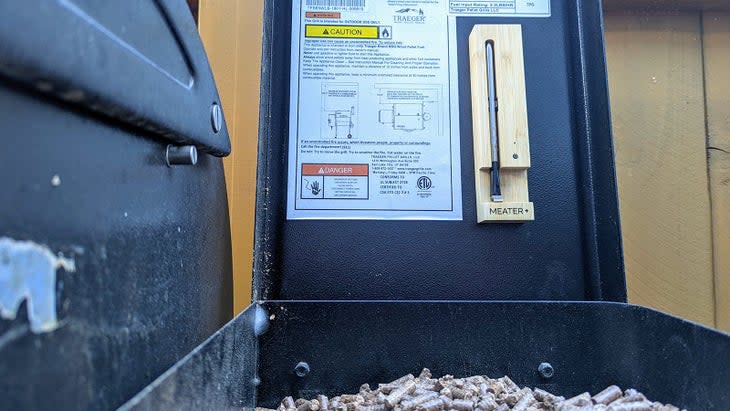
Who Is It For?
I'm an experienced amateur chef, meat lover, and even enjoy butchering my own wild game. Several years ago I set out to master the art of grilling a steak, and offer my friends a standing bet: if you can cook a better one, dinner and drinks are on me. Many a professional and hobbyist have tried, but thus far my wallet has remained closed.
The Meater Plus is adding a lot of convenience for me. It means I can leave the grill behind to focus on sides, conversations, or dogs, and it helps me give guests a more accurate estimate on when dinner's going to be ready. I think it'll add a similar level of convenience for virtually anyone else.
What if you're less experienced, or worry the high-tech Meater Plus might prove too complicated? You needn't worry. Paring the thermometer with your phone and using the Meater app are some of the easiest, most streamlined experiences I've had with wireless gadgets. There's not really anything you can do wrong, and you'll get accurate results every time you use the system.
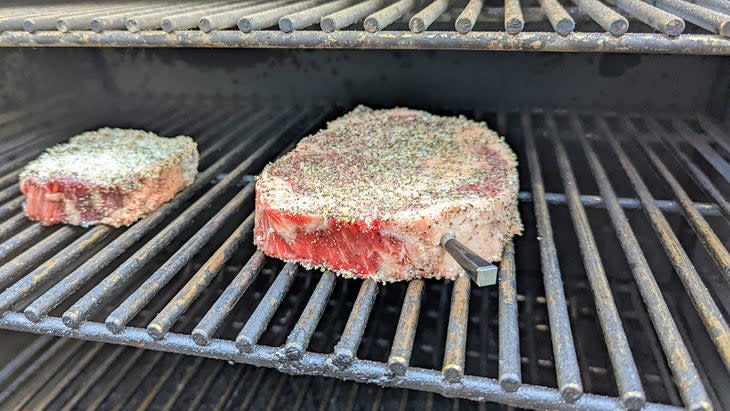
Meater Plus Design
There's some clever stuff going on here, underneath's the system's sleek, simple surface.
A single AAA battery installed in the rear of the charging base keeps the probe charged. The battery inside the probe itself can run for up to 24 hours, while that AAA will recharge it up to 100 times.
That base also serves as a Bluetooth signal repeater. Like most low power Bluetooth devices, the probe itself can transmit a signal only about 30 feet. So long as the base is located somewhere within that distance, it’ll read the signal, and then send that to your phone. The probe cannot connect with your phone on its own; you must use it with the base.
Made from open pore bamboo, the base complements the probe's good looks. This setup should look at home anywhere from a picnic table to a fancy kitchen.
The probe is dishwasher safe, but can more quickly just be wiped clean with a sponge and rinsed under the tap. In camp, I've just been wiping it clean with a paper towel just after it comes out of the meat. There's no surfaces on it that will hang onto any food residues.
And it does work outdoors. Because the system is battery powered and uses a Bluetooth connection, there's no need for power outlets, cell signal, or WiFi.
The maximum temperature the probe can take without damage is 212 degrees internal (the temperature of boiling water), and 527 degrees ambient. There's a visible notch on the probe's body that marks the minimum insertion depth, so you keep that internal thermometer safe. The app will warn you if you approach dangerous temperatures.
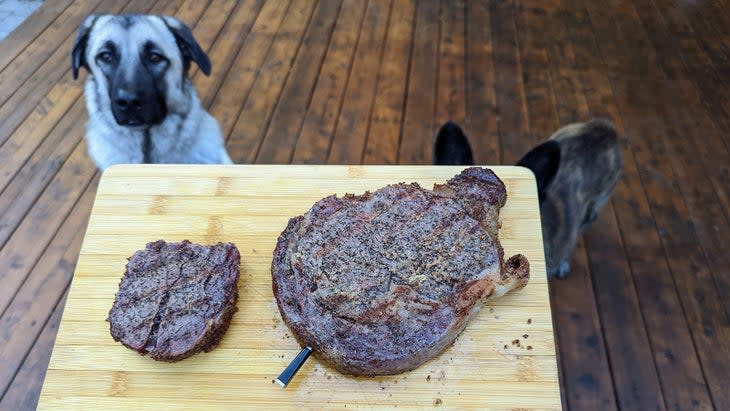
Using the Meater Plus
I've owned my Meater Plus for about a month now, and have been using it both at home and on camping trips in that time.
On the first camping trip, I cooked both sirloin steaks and chicken breasts for a large group, over an open campfire. While Meater Plus doesn't claim to be an instant read thermometer, inserting it in a new piece of meat produced stable temperature readings in under 30 seconds. And moving the very hot probe around between pieces of meat was easy using tongs, thanks to the flared head.
Cooking on a campfire is inherently inconsistent. The temperature produced by the fire will vary over time, and on different areas of the grill. But, because it measures both ambient and internal temperatures, Meater Plus produces solid ballpark estimates on total cook times. It also allowed me to move back from the fire, and enjoy a beer without the need to hover over the heat.
But the ribeye I cooked myself at home last night is probably most indicative of the system's utility. I was tired, and didn't feel like bothering with the two grills required by my best steak in the world method. So, I just used Traeger's own reverse sear recipe on my Timberline. That calls first for a smoke at 225 degrees grill temperature, while the steak comes up to 120 internal. Then you rest the meat, bring the grill up to 500, and return the steak, flipping it halfway to the 130 internal target temperature.
Using Meater Plus, I set an initial target of 120 internal, plus a 60 second warning alarm. I threw the steak on the grill, then cooked sweet potatoes and prepped asparagus in my kitchen, while chatting with my wife and wrestling with my dogs. Even one external and three internal walls, and about 100 feet away from the grill, I didn't have to worry about anything until I heard my phone chime. I brought the steak inside without having to pull a wired probe, used the app to the change the target to 130, then repeated the process 15 minutes later. The results were perfect, and the attention I had to devote was basically nothing.
Meater's temperature-over-time graph wasn't super useful this time, but I think that will be handy for longer smokes. With very fatty cuts of meat like a brisket, you experience what's known as a "stall," when the amount of fat turning to liquid actually provides enough of a cooling effect to temporarily halt cooking progress. The key to nailing a brisket or similar is taking advantage of that stall to fill the meat with moisture and flavor, and now armed with Meater Plus, I'll have more information about the the beginning, end, and duration of that phase, which will better enable me to employ tools like grill temperature and aluminum foil to take advantage of it.
One thing Meater Plus will not do is teach you how to cook. I've read other reviews that have complained that, while the system can estimate total cook time pretty well, it doesn't tell you when you should flip a piece of meat.
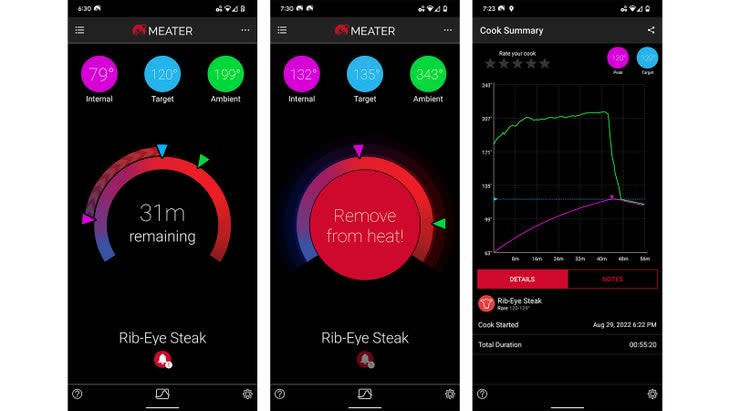
Likes
Simple app delivers information without hassle.
Tested against other thermometers and in known ambient temperatures, readings prove accurate.
165-foot range is generous, and seems undiminished by internal and external walls.
Easy to clean.
Reliable connection. In the space of a month, it's never dropped a connection on its own, or failed to reconnect immediately if I walked outside its range.
Dislikes
App could provide more learning opportunities with suggested flip temperatures.
If you plan to leave home, you'll need to pair Meater Plus with a tablet or similar that will remain behind in order for it to connect with WiFi, so you can monitor temperatures while away.
The probe is about twice the diameter of a normal wired thermometer. It may prove too thick for some very thin cuts of meat.
Meater's suggested temperatures--145 for a rib-eye--are way too high to produce edible results.
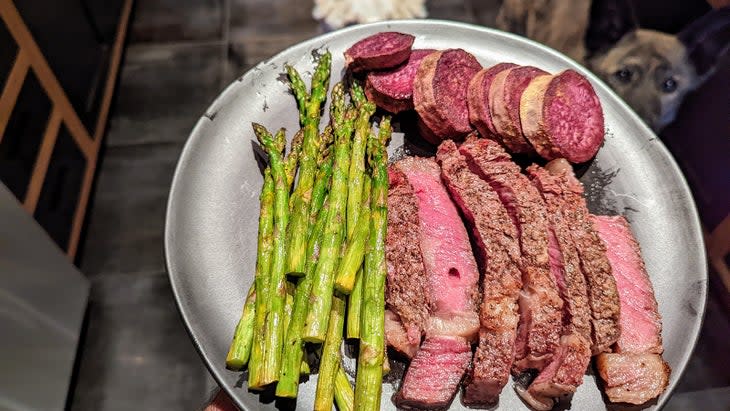
Should You Buy One?
At $100, Meater Plus is around ten times the price of simple, analog meat thermometers, and three times the price of basic digital thermometers with wired probes. The app's estimated cooking times and suggested temperatures aren't really enough to justify that premium, but the ability to remotely monitor temperatures from basically anywhere in your home is. If you regularly cook meat in your kitchen, on a grill, or in camp, Meater Plus will make the experience a lot more convenient.
For exclusive access to all of our fitness, gear, adventure, and travel stories, plus discounts on trips, events, and gear, sign up for Outside+ today.

